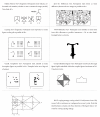Global and local perceptual style, field-independence, and central coherence: An attempt at concept validation
- PMID: 20523847
- PMCID: PMC2864999
- DOI: 10.2478/v10053-008-0062-8
Global and local perceptual style, field-independence, and central coherence: An attempt at concept validation
Abstract
Historically, the concepts of field-independence, closure flexibility, and weak central coherence have been used to denote a locally, rather globally, dominated perceptual style. To date, there has been little attempt to clarify the relationship between these constructs, or to examine the convergent validity of the various tasks purported to measure them. To address this, we administered 14 tasks that have been used to study visual perceptual styles to a group of 90 neuro-typical adults. The data were subjected to exploratory factor analysis. We found evidence for the existence of a narrowly defined weak central coherence (field-independence) factor that received loadings from only a few of the tasks used to operationalise this concept. This factor can most aptly be described as representing the ability to dis-embed a simple stimulus from a more complex array. The results suggest that future studies of perceptual styles should include tasks whose theoretical validity is empirically verified, as such validity cannot be established merely on the basis of a priori task analysis. Moreover, the use of multiple indices is required to capture the latent dimensions of perceptual styles reliably.
Keywords: central coherence; closure flexibility; factor analysis; field-independence; global/local perception; perceptual style; visual perception.
Figures


Similar articles
-
The Leuven Embedded Figures Test (L-EFT): measuring perception, intelligence or executive function?PeerJ. 2018 Mar 26;6:e4524. doi: 10.7717/peerj.4524. eCollection 2018. PeerJ. 2018. PMID: 29607257 Free PMC article.
-
Perceptual style and dual-task performance as a function of task difficulty and task emphasis.Percept Mot Skills. 1985 Dec;61(3 Pt 2):1091-105. doi: 10.2466/pms.1985.61.3f.1091. Percept Mot Skills. 1985. PMID: 4094852
-
The field dependence/independence cognitive style does not control the spatial perception of elevation.Percept Psychophys. 2006 Apr;68(3):377-92. doi: 10.3758/bf03193684. Percept Psychophys. 2006. PMID: 16900831
-
Field independence: reviewing the evidence.Br J Educ Psychol. 2013 Jun;83(Pt 2):210-24. doi: 10.1111/bjep.12015. Epub 2013 Apr 12. Br J Educ Psychol. 2013. PMID: 23692531 Review.
-
Perceptual learning in Vision Research.Vision Res. 2011 Jul 1;51(13):1552-66. doi: 10.1016/j.visres.2010.10.019. Epub 2010 Oct 23. Vision Res. 2011. PMID: 20974167 Review.
Cited by
-
Strong Bias Towards Analytic Perception in ASD Does not Necessarily Come at the Price of Impaired Integration Skills.J Autism Dev Disord. 2015 Jun;45(6):1499-512. doi: 10.1007/s10803-014-2293-5. J Autism Dev Disord. 2015. PMID: 25518823
-
Autism: Hard to Switch from Details to the Whole.J Abnorm Child Psychol. 2018 Aug;46(6):1359-1371. doi: 10.1007/s10802-017-0384-4. J Abnorm Child Psychol. 2018. PMID: 29250728
-
Disturbed interplay between mid- and high-level vision in ASD? Evidence from a contour identification task with everyday objects.J Autism Dev Disord. 2014 Apr;44(4):801-15. doi: 10.1007/s10803-013-1931-7. J Autism Dev Disord. 2014. PMID: 24037639
-
Evidence for a cultural influence on field-independence in autism spectrum disorder.J Autism Dev Disord. 2012 Feb;42(2):181-90. doi: 10.1007/s10803-011-1232-y. J Autism Dev Disord. 2012. PMID: 21455794
-
When illusions merge.J Vis. 2020 Aug 3;20(8):12. doi: 10.1167/jov.20.8.12. J Vis. 2020. PMID: 32766743 Free PMC article.
References
-
- Booth R. King’s College London; 2006. Local-global processing and cognitive style in autism spectrum disorder and typical development. Unpublished PhD thesis.
-
- Blunch N. J. Introduction to structural equation modelling using SPSS and AMOS. London: Sage Ltd; 2008.
-
- Brosnan M., Demetre J., Hamill S., Robson K., Shepherd H., Cody G. Executive functioning in adults and children with developmental dyslexia. Neuropsychologia. 2002;40:2144–2155. - PubMed
-
- Brosnan M., Scott F. J., Fox S., Pye J. Gestalt processing in autism: Failure to process perceptual relationship and the implications for contextual understanding. Journal of Child Psychology and Psychiatry. 2004;45:459–469. - PubMed
LinkOut - more resources
Full Text Sources
